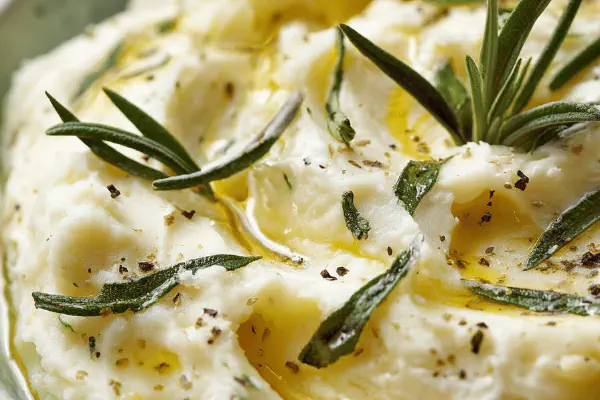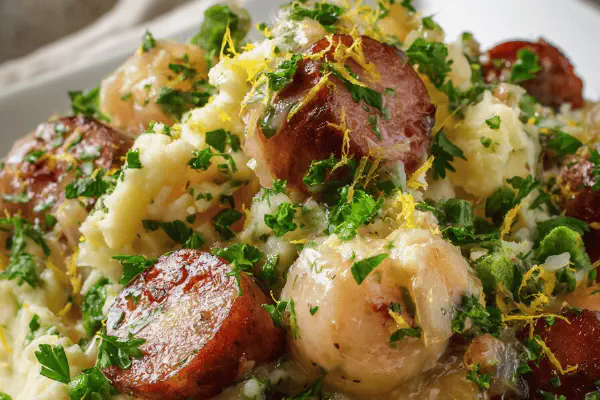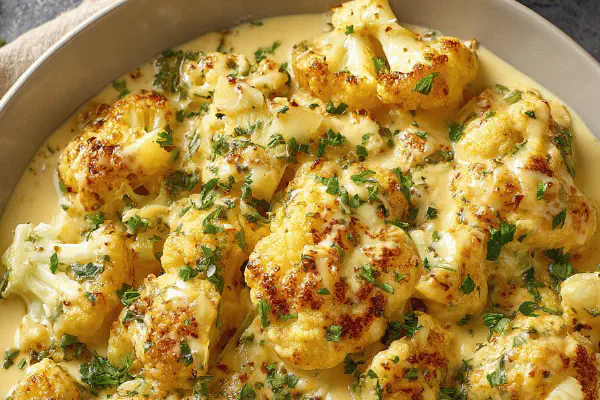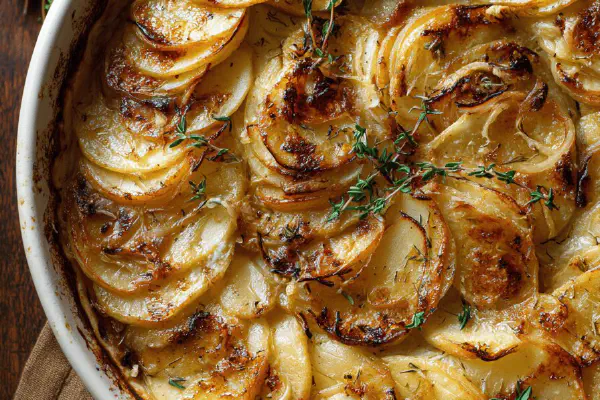Chive Buttermilk Mash

By Emma
Certified Culinary Professional
Ingredients
- 6 medium round potatoes, peeled and chunked
- 70 ml unsalted butter, softened
- 180 ml kefir, chilled
- 45 ml fresh tarragon, finely chopped
- Salt
- Freshly cracked black pepper
About the ingredients
Method
- Start by boiling cubed potatoes in salted water, watching for fork-tender texture, around 20 minutes but check early to avoid mealy mush; vibrant potatoes give subtle creaminess.
- Drain well, then return to pot, low heat; shaking pot gently to steam dry excess moisture for 2 minutes or until surface feels dry–this keeps mash fluffy and firm.
- Add softened butter right on hot spuds; mash coarsely with sturdy masher to keep bite, mixing enough to absorb butter fats throughout.
- Switch to electric mixer for final whip, pouring kefir slowly while mixing; texture turns airy and tangy, kefir bringing brightness missing with buttermilk substitute.
- Fold in chopped tarragon last; its sharp, herbaceous aroma challenges the common chive subtlety, giving unexpected freshness.
- Season mindfully with salt and cracked pepper; taste along, butter and kefir affect salt absorption differently than classic buttermilk recipes.
- Serve warm; you want earthy potato scent mingling with buttery richness and herb punch. If potatoes become gluey, likely over-mashing or too much liquid—lesson learned the hard way.
Cooking tips
Chef's notes
- 💡 Boil potatoes whole or chunked. Salt water mandatory. Check doneness by fork feel not clock. Early poke avoids mealy mush. Draining well then steaming low heat evaporates hidden excess water. Keeps mash fluffy and firm. Skip steam dry step, ends wet gluey mess. Timing varies by potato. Tactile approach essential here.
- 💡 Butter must be unsalted and softened or mash becomes cold spots, uneven texture. Add butter when potatoes still hot. Fats coat starch better that way. Cold butter ruins cohesion, lumps appear. Mash coarsely first; preserve bite. Overworking crushes texture, becomes gummy. Later whip with mixer and kefir; brings air and tang. Sequence matters hugely.
- 💡 Kefir replaces buttermilk—adds acidity plus creaminess, probiotic hints. Add kefir slow while mixing to not break structure. Start whipping first for coarse texture then aerate gently. Can swap kefir for light cream or yogurt but that shifts tang and texture subtly. Kefir freshness impacts brightness perceptibly.
- 💡 Herbs last step always. Tarragon sharply different from chives; anise aroma alters whole flavor. Chop finely but do not purée. Adding herbs earlier dulls aroma, sometimes turns bitter if overcooked or mixed in too soon. Fresh preferred over dried. Dried use sparingly. Herb timing safeguards both scent and bite.
- 💡 Overmixing is mash killer. Gluey texture signals starch break down or too much liquid. Avoid long mixing. If glue happens, fix try holding back liquid next batch or stop mixing early. If too stiff, add small warmed cream splash—not cold liquid. Scooping texture with sturdy masher before whipping balances rustic with lightness. Experience tells when.
Common questions
Why steam dry potatoes after draining?
Water hides in starchy surface pockets. Draining removes free water but not that. Low heat steam dries surface gently. Prevents soggy mash, keeps fluffiness. Skipping step risks gluey texture. Watch pot shake, feel surface moisture fade—key sensory cue.
Can I substitute kefir with sour cream or yogurt?
Yes but flavor changes. Sour cream heavier, less tangy. Yogurt tang present but texture thicker, risk lumping if cold added fast. Kefir thinner, adds probiotics too. If using alternatives, warm slightly and add slow while mixing. Adjust salt afterwards; acidity affects perception.
How to fix gluey mashed potatoes?
Stop mixing immediately once glue sets. Next time drain and steam dry potato chunks longer. Use coarse mash first, then whip gently with mixer. Add less liquid gradually. Warmed cream splash helps loosen stiff mash but don't overdo. Cold butter spots cause lumps, soften fully beforehand.
Best way to store leftovers?
Cool quickly, store airtight. Refrigerate for few days max. Reheat gently on stovetop with bit milk or cream to restore softness; microwave risks drying. Could freeze but texture suffers; better mash fresh. Add extra butter or kefir when reheating to bring back creaminess and tang. Stir carefully, avoid overmixing.



